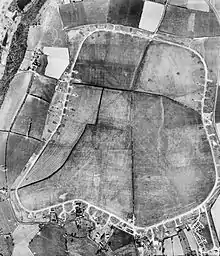RAF Zeals
RAF Zeals was a wartime Royal Air Force station in Wiltshire, sited to the north of the village of Zeals, next to the village of Stourton and the Stourhead estate.
| RAF Zeals | |
|---|---|
 Aerial photograph of Zeals airfield: control tower, technical site and blister hangars at the bottom (south), 24 March 1944. | |
| Active | 1942–1946 |
| Country | United Kingdom |
| Branch | Royal Air Force |
| Type | Aerodrome |
| Garrison/HQ | |
| Royal Air Force Ensign |  |
History
The station was in operation from 1942 to 1946, and was successively occupied by the Royal Air Force, the United States Army Air Force and the Royal Navy.
From opening until August 1943 the site was used by the RAF as an airfield for Hawker Hurricane and Supermarine Spitfire fighters.
In August 1943 it was transferred to the United States Army Air Force with the intention of using the airfield for maintenance of C-47 Skytrain transport aircraft. However, the damp conditions prevented the operation of heavy aircraft, so P-47 Thunderbolt fighters were flown from Zeals instead.
From March 1944, it returned to the RAF who used it as a fighter airfield for de Havilland Mosquito fighters against German bombers.
Following D-Day, the RAF used the airfield for military glider training in preparation for action against Japan. In April 1945 the station was taken over by the Royal Navy (as HMS Hummingbird or RNAS Zeals) who used the airfield for aircraft carrier training.
The airfield was closed down from January 1946 and in June it was returned to farmland. The control tower, now a private house, remains on Bells Lane in Zeals.
Dakota crash – 19 February 1945
Dakota III TS436 was assigned to the Glider Pick-Up Training Flt, whose role was to train crews in the 'snatch take-off method for retrieving gliders. Those on board were mostly returning to their base in Leicester, on completion of the course of instruction at Zeals. The aircraft took off at 1523 hours in conditions of broken cloud, with some patches down to 100 feet and generally overcast, a westerly wind at 10 mph and visibility of 1 to 2 miles at ground level. The pilot made a quarter circuit of the airfield and then set course to the north-east. Three minutes later whilst flying in and out of the broken cloud and whilst in level flight, the aircraft flew into a clump of 60-foot tall beech trees on top of a knoll. The impact ripped 10 feet off the port wing and the aircraft rolled to port, hit two more trees and then impaled itself on a cluster of four mature trees, caught fire and disintegrated, scattering wreckage over a distance of 300 yards on the far side of the knoll. Destruction of the aircraft was complete but investigation revealed the engines to have been at a high power setting on impact. The Accident Report, published on 17 May 45, suggests that the pilot – who was the sole survivor – had failed to climb to a safe height when flying in poor visibility, although the knoll was a well known obstruction in close proximity to the airfield.
The tragic sequel to this loss is that the pilot, who had been awarded the DFC for his gallantry on operations, followed a restless career afterwards, leaving and returning to the RAF, until finally joining the Foreign Service and being appointed an Assistant District Officer. While on assignment in Kenya, he committed suicide.
The twenty killed:
- Flight Lieutenant Reed Tilton HYDE 33 RCAF
- Flying Officer James Cassells HOWDEN 29 RCAF Pilot
- Flying Officer Gerard Jean GUAY 24 RCAF Wireless Operator
- Flying Officer Mervyn Esmond Llewellyn SCOVELL 33 RCAF Navigator
- Flight Sergeant Alan Geoffrey SHADDICK 20 RAAF Pilot
- Flight Sergeant John Ogilvy ALLEN 21 RAAF Wireless Operator
- Flight Sergeant Leslie Daniel SLIPPER 21 Pilot
- Flight Lieutenant Thomas Arthur EVANS 23 Pilot
- Flight Lieutenant Alan James ROBERTS 23 Pilot
- Flying Officer Sidney Graham WILLIAMS Navigator
- Flight Sergeant Donald GRANT 21 Navigator
- Flight Sergeant Maxwell Vernon GILDER
- Flight Sergeant James ROSS 24 Flight Engineer
- Flight Sergeant Ronald Edward JELFS 23 Flight Engineer
- Flight Lieutenant Douglas Elliott TURNBULL 23 Wireless Operator
- Flight Lieutenant John HEYWOOD Equipment Officer
- Corporal Kenneth Stanley ANDERSON
- Aircraftman 2nd Class Reginald Ernest SUGGARS
- Aircraftman 2nd Class Walter James COLBY 44
- Flight Lieutenant Frank Joseph PLANT 27 Navigator.

The site of the crash is marked by a memorial which was erected by the Wiltshire Historical Military Society at Beech Clump (ST 791 347) near Search Farm, Stourton, 1.3 miles north-east of RAF Zeals. The National Trust, who own Beech Knoll, were approached and gave permission for the memorial to be placed on the hilltop. Relatives and former comrades of those who died, some of whom where Australian and Canadian, were traced and contacted; together with the local community they funded the memorial.
On 14 August 1999 a dedication and unveiling ceremony took place, in the presence of 150 relatives and guests. The memorial was unveiled by Air Chief Marshal Sir John Gingell GBE, KCB, KCVO RAF and the dedication was conducted by Canon F Davey, a former WWII Coastal Command navigator. The RAF was represented by Wg Cdr John Barras OC 30 Squadron, RAF Lyneham; the Royal Australian Air Force by SqnLdr Greg Shaw and the Royal Canadian Air Force by Capt Kirk Bennett. The 'Last Post' was played by an RAF bugler and Dakota N47FK of the Dakota Club, based at North Weald, carried out a fly-past.